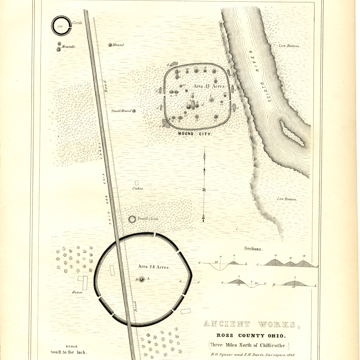The Mound City Group National Monument includes a 13-acre nearly square earthen enclosure surrounding about two dozen conical or oval burial mounds. There are two additional mounds located just outside the enclosure. The low earthen wall enclosure has openings on the east and west sides. The Hopewell cremated their dead in a charnel house, then burned the charnel house and built a mound over its remains. They also placed artifacts in the mound, such as copper figures, projectile points, pipes, shells, and mica.
The army training installation of Camp Sherman was located at the Mound City Group site during World War I. The military camp was dismantled after the war and in the early 1920s the Ohio Historical Society (now known as the Ohio History Connection) began reconstructing the Hopewell earthworks and mounds based on archaeological investigations. Mound City Group became a National Monument in 1923.
References
“Hopewell Culture, National Historical Park, Ohio.” National Park Service. Accessed November 20, 2018. https://www.nps.gov/.
Lepper, Bradley T. “Archaeology of the Hopewell Culture.” In Encyclopedia of Global Archaeology, edited by Claire Smith. New York: Springer New York, 2013.
Lepper, Bradley T. Ohio Archaeology: an illustrated chronicle of Ohio's ancient American Indian cultures. Wilmington, OH: Orange Frazer Press, 2005.
Lynott, Mark J. Hopewell Ceremonial Landscapes of Ohio, More than Mounds and Geometric Earthworks. American Landscapes Series. Havertown, PA: Oxbow Books, 2015.
Squier, Ephraim G., and Davis, Edwin H. Ancient Monuments of the Mississippi Valley.1848. Reprint, Washington D.C.: Smithsonian Institution Press, 1998.
Weiss, Francine, “Hopeton Earthworks,” Ross County, Ohio. National Historic Landmark Nomination Form, 1975. National Park Service, U.S. Department of the Interior, Washington, DC.
Weiss, Francine, “Mound City Group National Monument,” Ross County, Ohio. National Historic Landmark Nomination Form, 1975. National Park Service, U.S. Department of the Interior, Washington, DC.

